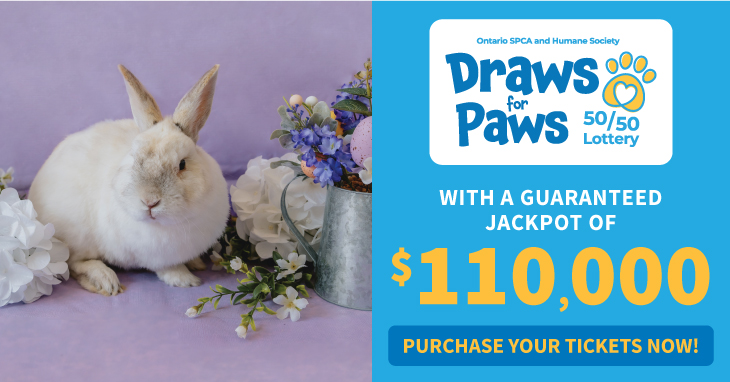Cottage safety tips for your dog
by Ontario SPCA and Humane Society | General Pet Care | August 3, 2023

During summer months, many families will head to the cottage! The cottage setting is very different than your furry friend’s normal routine at home and there are safety considerations to keep in mind to make it an enjoyable cottage season for everyone.
Arriving safely
For your animal’s safety and your own, confine them to the back seat, either in a carrier or pet seatbelt (a special harness that attaches to the car’s seatbelt) when driving to the cottage. To help keep your animal comfortable throughout the trip:
- Keep the car at a comfortable temperature, using air conditioning when necessary. Never leave your animal alone inside the vehicle, even with windows partially open. Even a short time in a hot environment can be life-threatening for your pet.
- Run errands before you hit the road to minimize the need for stops. This is critical if you are travelling alone and do not have someone to stay with your pet if you need to leave the vehicle.
- Feed your furry friend a light meal at least four hours before the trip (to help prevent car sickness).
- Prevent your animal from sticking their head out the window (sudden stops and debris can cause injury).
- Schedule rest stops every two to four hours for exercise, bathroom and water breaks (bring a litter box for cats).
- Attach your animal’s leash before opening the car door to prevent them from accidentally escaping.
- If your pet is not used to travelling, use a harness (it’s more difficult for your pet to wriggle out of).
- Keep the car sound system volume moderate as cats and dogs have sensitive hearing.
Pets on the loose!
People sometimes think that in a cottage setting, companion animals can be allowed to run at-large. The sad truth is that many of these animals become lost, are hit by cars, get into fights, or run into situations with wildlife.
It’s important our furry friends stay safely confined to your cottage property and wear identification that has the address and phone number of your cottage. If your animal is microchipped, contact the microchip company and inform them of your weekend address and phone number. Be prepared and have the phone number of the local animal control facility and the local animal shelters in your cottage region.
Healthy = happy at the cottage
A preventative care plan for your animal will help protect them against disease and parasites, especially while at the cottage. It is recommended to speak with your veterinarian about preventative flea and tick medications, as well as to ensure your pet is up to date with all their vaccines. It is recommended to have the phone number of a veterinarian in your cottage area, just in case emergency veterinary attention for your animal is required.
Water safety
If you plan to take your animal out on the water boating with you, be sure to invest in a pet life jacket. Even good swimmers can tire easily in rough water, and banks may be slippery or too steep to climb up. Life jackets not only keep your pet afloat if they decide to “jump ship,” they can also help protect against hypothermia in cold water and can also make it easier to pull them back onboard. Learn how to fit your dog for a lifejacket.
It’s important to remember that it can get very hot on the boat so be sure to provide a shaded area for your pet to rest and bring plenty of fresh water to prevent dehydration and/or heat stroke. Plan stops at public rest areas where you can disembark and give your dog a break on land.
If you are planning to be on the water for a long period of time, you may need to bring a portable potty system (some dogs will use a pee pad, a square piece of turf may work for some dogs or look up “pets and portable potty system” for available options).
Swimming tips
- Always ensure your dog is supervised at all times. Life jackets are also a good idea, particularly for older dogs, or dogs who are not strong swimmers.
- Remove chain or slip collars before your dog goes into the water. These collars can snag a dog on hidden underwater obstacles, such as plants, branches or debris.
- Watch the water before allowing your dog to swim. Moving water can be dangerous. Even if the water appears to be moving slowly, the volume of moving water can make it difficult for a dog to swim against the current. If the current or wind appears too strong, let your dog splash close to shore instead.
- Check the water temperature. A dog will generally tire out more quickly in cold water and can lose energy, develop cramps and be at risk for hypothermia.
- Call your dog out of the water before he’s too tired – a tired dog has a much higher risk of drowning.
Pets and wildlife – Be aware!
Problems can arise when your pet encounters a wild animal. Pets should NOT be allowed to chase and/or injure wildlife. Keeping your pet on leash will help protect them from wildlife as well. For example, quills from a porcupine can be a very painful experience, and skunk spray can sting the eyes – plus that’s not a smell you want in your cottage! There are also illnesses that can be passed from wildlife to domestic animals.
Follow these simple suggestions to help ensure that you and your animals enjoy a relaxing time at the cottage this summer.
Categories
Testimonial
Your dedication and support
It is with and because of your dedication and support that helpless animals are being saved. Thank you for everything.
